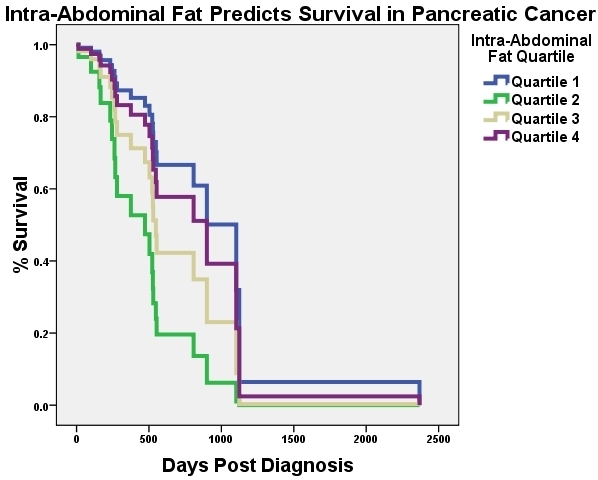Back to Program | 2010 Program and Abstracts Overview | 2010 Posters
Intra-Abdominal Fat Predicts Survival in Pancreatic Cancer
Courtney Balentine*1,2, Jose Enriquez1,3, William E. Fisher1,3, Sally Hodges3,1, Vivek Bansal4, Shubhada Sansgiry2, Nancy J. Petersen2, David H. Berger1,2
1Michael E DeBakey Department of Surgery, Baylor College of Medicine, Houston, TX; 2Michael E DeBakey Veterans Affairs Hospital, Houston, TX; 3Elkins Pancreas Center, Baylor College of Medicine, Houston, TX; 4Radiology, Baylor College of Medicine, Houston, TX
>Background The impact of obesity on survival after pancreatic cancer surgery remains controversial. This may be due to the fact that obesity has been calculated by body mass index (BMI), an indirect measure that does not account for fat distribution. We hypothesized that directly measuring intra-abdominal fat would better predict survival.MethodsPatients who had a Whipple procedure for pancreatic adenocarcinoma from 2000-2009 were selected from institutional cancer databases at two hospitals. Preoperative CT imaging was used to measure intra-abdominal fat. Cox regression analyses were used to identify independent predictors of survival.ResultsSixty-one patients from 2000-2009 underwent a Whipple procedure for exocrine pancreatic adenocarcinoma. After adjusting for age and perineural invasion status, preoperative BMI was not a significant independent predictor of overall survival (p<0.827). Unlike BMI, quartile of intra-abdominal fat did influence survival. Relative to patients with the lowest quantity of intra-abdominal fat (lowest quartile), those with more intra-abdominal fat tended to show worse overall survival but in a non-linear fashion(Figure 1). Individuals in the second quartile showed a 4-fold increase in likelihood of death (HR 4.018, 95% CI 1.099-14.687, p<0.035) relative to the lowest quartile. Patients in the third (HR 2.124, 95% CI 0.278-16.222, p<0.468) and fourth quartile (HR 1.354, 95% CI 0.296-6.190, p<0.696) also showed greater risk of death but neither achieved statistical significance. ConclusionsAlthough BMI does not significantly predict survival in pancreatic cancer, increased intra-abdominal fat does identify a subset of patients with worse prognosis . This novel approach to measuring abdominal adiposity deserves further study to explore the relationship between obesity and outcomes in pancreatic cancer.
Back to Program | 2010 Program and Abstracts Overview | 2010 Posters



